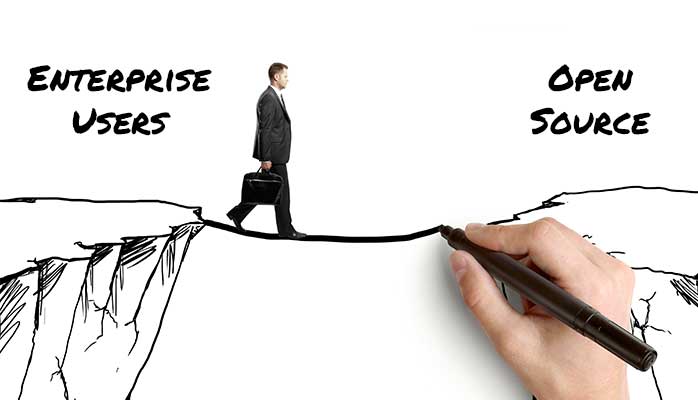What if a critical portion of your business strategy were based on a mistaken notion? Of course you’d want to know, right?
If you’ve made the assumption that proprietary enterprise software is superior to open source enterprise software, you’re not alone. And you’re not alone in being mistaken.
The conceptual divide today between open source software and enterprise users can seem like a permanent fixture, bolstered by calcified and prejudiced notions. Yet, it is increasingly likely that your brightest IT future may depend on bridging that conceptual divide. To do so, it is helpful to take a look back at historical examples of the clash between open source and proprietary endeavors. And perhaps there’s no better example than the epic battle between Encarta and Wikipedia.
In the early 1990’s, Microsoft founder Bill Gates launched Encarta, a for-purchase DVD- format encyclopedia complete with sound and graphics. Encarta was created in a top-down, academic way. Much the same way, in fact, that proprietary software is created. It was researched, written, and edited by a team of paid experts at great expense. Although still commercially licensed and proprietary, thanks to emerging DVD technology, the rich media information cost less than similar information in print format. A set of Encarta DVDs cost significantly less (hundreds or even thousands of dollars less) than a set of traditional print-format encyclopedias, and Encarta was perceived as being equally as accurate as the traditional printed encyclopedias. Encarta hugely undercut sales of the leading print encyclopedia, Encyclopedia Britannica, and it appeared for a time that Encarta would forever dominate that market space. But the mighty Encarta was soon to face a life-or-death challenge from an unlikely rival.
Jimmy Wales launched Wikipedia in 2001. Wales envisioned a free, online encyclopedia for everyone, written and edited by…everyone. This endeavor (essentially an open source encyclopedia project) was met with derision and ridicule from detractors, who asserted that something created and worked on so freely and openly could not possibly yield a high-quality, accurate product (an argument often put forth about open source software by industry naysayers). Studies found, however, that the rate of accuracy of Wikipedia articles was as good as that of Encarta and Britannica, yet the Wikipedia information cost…nothing.
As this 2005 CNET article put it, “Wikipedia is about as good a source of accurate information as Britannica, the venerable standard-bearer of facts about the world around us, according to a study published this week in the journal Nature.”
“Certainly Wikipedia’s open source model could allow all sorts of inaccurate, misleading and biased information to be found,” wrote Paul Gray in his 2009 article on the topic. He continued, “However these criticisms have been made of traditional published encyclopedias for decades. The reality is that the peer-review structure of Wikipedia means that errors are often rectified quickly, and controversial articles can be locked so that only registered members can make changes, minimizing the likelihood of editorial vandalism.”
Gray also noted that other encyclopedias simply could not compete with Wikipedia’s seemingly limitless resources. “Wikipedia’s sources were infinite; its pool of contributors was made up of anyone, anywhere who wanted to add anything. They were paid nothing and given no writing credits. Rather than periodic updates, Wikipedia was updated continually – and instantly. This open model allowed Wikipedia’s English language version to exceed over 2.7 million entries as of March 2009 – compared to 62,000 in Encarta.”
In a Time Magazine article, Wikipedia founder Jimmy Wales explained, “The main reason we allow everyone to edit is quality. It’s about allowing for an open, democratic dialogue to get the best possible entry that we can. The great beauty of the Internet is that it allows for a huge range of people to participate constructively.”
Ultimately, Wikipedia prevailed over Encarta. In a March 2009 New York Times article, writer Noam Cohen observed that “Microsoft delivered the coup de grâce Monday to its dying Encarta encyclopedia, acknowledging what everyone else realized long ago: it just couldn’t compete with Wikipedia, a free, collaborative project that has become the leading encyclopedia on the Web.”
Any comparison is accurate only to a point, of course, and my intention here is not to assert that open source software will ultimately render all proprietary software obsolete. Rather, my goal is to dispel some common myths and misunderstandings about open source software as a first step in bridging the conceptual divide between open source and the majority of enterprise software users. The perception that there can be no effective application of open source software in enterprise systems is an illusion, and perpetuating that illusion hurts the competitiveness of those who are duped.
Open source is really just another way to license software, and ultimately open source licenses can encourage contributions from a wide variety of individuals — a talent pool that can extend way beyond the bounds of just one corporate IT staff developing a product in-house. Also, open source licenses can allow for large, high-quality software systems to be available without any licensing fees.
It’s fair to say that complex enterprise systems require technical design, implementation and support efforts that are specific to each customer. It’s also fair to say that those efforts can and should be billed. But the upfront and recurring licensing fees that come along with proprietary software (often $1 in licensing fees for every $2 spent on implementation) can be saved by leveraging a free open source licensing approach.
Pay it forward, if you will. Give more, get more. Once a software product is built, the incremental cost of making a copy of the code for a new client project is negligible. So why do some companies charge big licensing fees for proprietary software products anyway? Just because they can.
It may surprise some proprietary enterprise software users to learn that open source is already leading the way in many critical areas of the enterprise. Pairing open source technology with a commercial business to refine marketing and delivery to the enterprise user is a hybrid model that is proving highly successful. For some specific examples, you could consider:
- Apache Cassandra, paired with Datastax, offering an open source database that they describe as “…the first viable alternative to Oracle for companies who are transforming the way they interact with customers.”
- Apache Hadoop, another open source big data offering coupled withHortonworks, which just went public some weeks ago.
- Apache Solr, open source enterprise search driving sites including Netflix, Zappos, Apple and NASA, paired with Lucidworks.
As a 20-year web software industry veteran who has seen quite a bit of both open source and proprietary enterprise software methodology, my team and I chose open source as the foundation for HotWax Systems’ commerce platform product—Apache OFBiz Accelerator, powered by Apache OFBiz. It’s a choice that has proven time and time again to be a great one.
By embracing open source, we are able to work freely with a code base that is shared right out in the sunshine with anyone and everyone interested in taking a look. Changes to the code base itself are carefully managed by an elected and tightly-coordinated team of skilled volunteer engineers representing many countries and industries around the globe. The software project management standards at theApache Software Foundation are, in fact, far higher than we generally find in corporate software organizations.
That code base, by virtue of its diverse group of contributors, is flexible by design, allowing us in turn to design, implement and support incredibly customizable systems. Rather than reduce each customer to the lowest common denominator that is “out-of-the-box proprietary software” and makes every user the same by definition, our open source approach empowers us to leverage the unique competitive advantages that each of our clients enjoys, helping each client be its best, unique self. The end result is better, more custom systems at lower costs than proprietary alternatives.
We are committed to nurturing and supporting the Apache Software Foundation open source ecosystem and to sharing our product development efforts with the open source community. We support, and our CTO chairs, the project management committee for Apache OFBiz, and we employ a large number of core committers to the OFBiz project. Our digital commerce platform is powered by Apache OFBiz and a strategic selection of additional Apache open source projects, and we continuously drive innovation in the Apache community.
Our active open source project leadership and significant technology contributions further the development and usefulness of OFBiz and many other Apache projects for businesses of all shapes and sizes. And just as we give, we get back from an amazingly diverse and talented community of software experts located around the world, working in a variety of different industries, all contributing their efforts to the open source project free of charge.
Working together, transparently, and out in the open, we can save businesses money and make better software! For the benefit of all, we can correct the fallacy that open source and enterprise software don’t mix, driving a new degree of differentiation, customization, and competitive advantage. I would love to hear your input on the topic, so take a second and let me know what you think.



